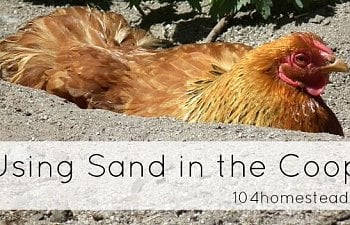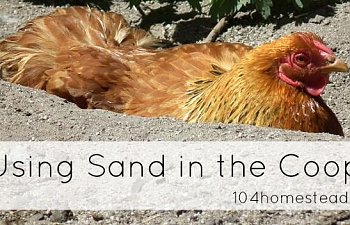Using Sand In the Chicken Coop
Sand is the answer to an obsessive person’s dreams. Close your eyes and imagine: Beautifully manicured chicken feet (free of poo), zen garden furrows in the ground, everything staying in its place instead of blowing around whenever a wing is flapped. Imagine walking in and smelling… nothing. Sand in the coop, my friends, is the answer.
I started last spring using sand in the coop and run. The birds had decimated the lawn leaving treacherous mud in its wake. Getting to the water station was becoming an Olympic feat. As usual, I turned BackYardChickens.com People were singing the praises of using sand to help with drainage and to replace more traditional bedding options.
Traditional bedding can be a nightmare in a run because it is exposed to the elements. It can get soggy, moldy or just smell terrible. The sand suffers none of those problems. There are, however, things you must do so that your sand does what you want it to do.
Choosing the Right Sand
- Type: It should be sand that has various sizes mixed in. Bank run or construction sand are great choices. Playsand and sandbox sand floats and you will regret using it.
- Depth: A thin layer will not give you the results you want. Poo will shift below to the ground and stink to high heaven. In the coop you can get away with 3-4″ so long as it’s not placed right on the ground. This is good for coops with plywood or a lined floor. In the run, 6-8″ is ideal for drainage.
Even More Pros
In addition to the “pros” already mentioned, here are a few more reasons to choose sand:
- It’s cost-effective. For anywhere from $10-$20 you can get an entire truckload of sand from a quarry.
- It creates a natural dust bath area and provides all the grit you could need.
- It stays dry. It quickly dries poo and doesn’t retain moisture so you don’t need to worry about mold or bugs.
- It stays cool in the summer, even during the biggest heat waves.
- It conserves feed. Pelletized feed stays on the surface and can easily be found by hungry birds.
- Composting made easy! No bedding that needs to be broken down.
- Aesthetically pleasing. You can even create a nice zen garden feel (though the birds may not appreciate your efforts and destroy it quickly).
- Less chance of frostbite during the winter because there is no moisture to build up.
Maintenance
Maintenance is super easy too! A modified stall rake makes a giant kitty litter scoop. Just use zip ties to attach some hardware cloth. Once a year I completely clean out the coop and add new sand. Twice a year I add some pelletized lime to the run and refresh any lost sand in the run. In the winter I throw in some ash from the fireplace and in the summer I sprinkle in some DE.


